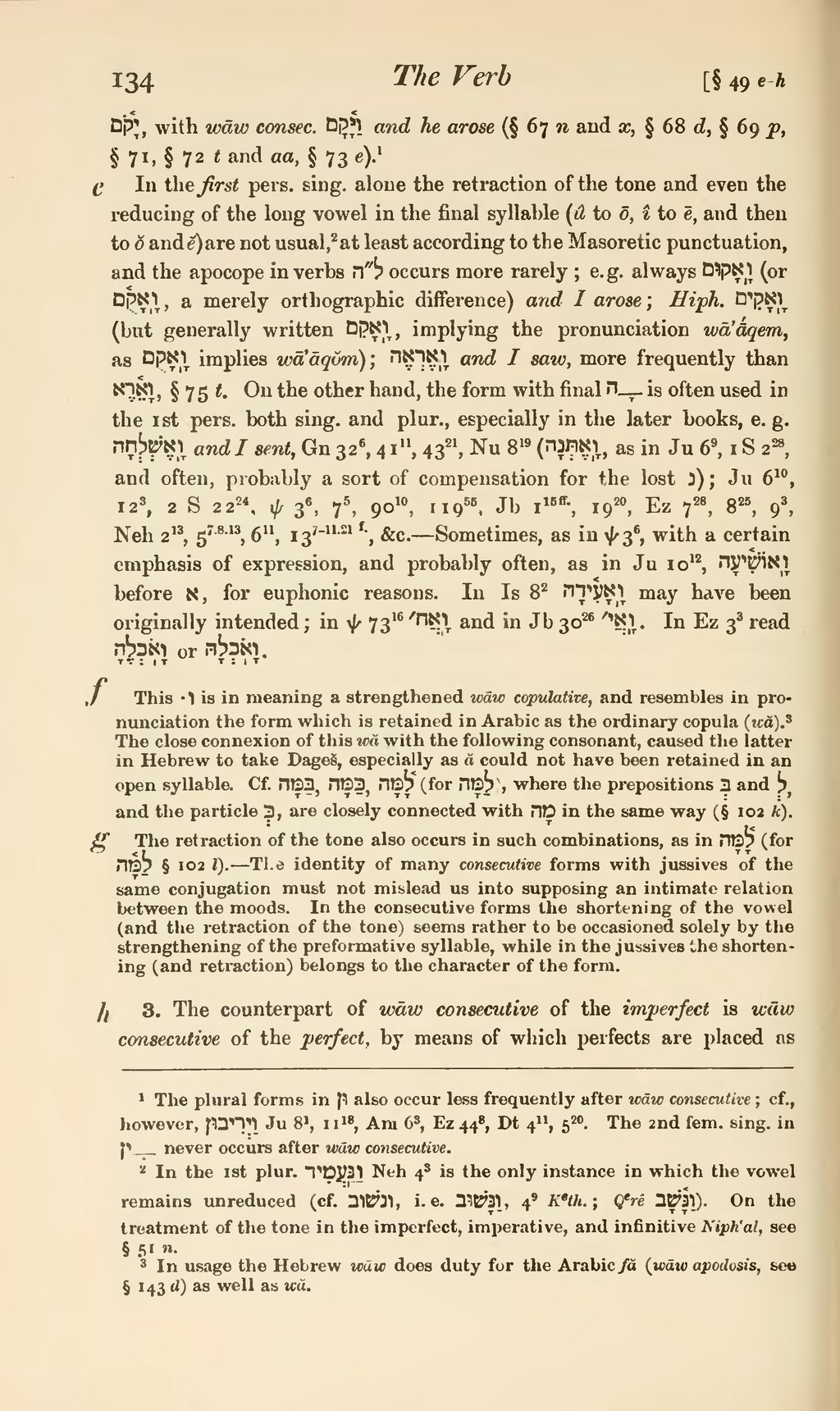יָקֹ֫ם, with wāw consec. וַיָּ֫קָם and he arose (§ 67 n and x, § 68 d, § 69 p, § 71, § 72 t and aa, § 73 e).[1]
[e] In the first pers. sing. alone the retraction of the tone and even the reducing of the long vowel in the final syllable (û to ō, î to ē, and then to ŏ and ĕ) are not usual,[2] at least according to the Masoretic punctuation, and the apocope in verbs ל״ה occurs more rarely; e.g. always וָֽאָקוּם (or וָֽאָקֻ֫ם, a merely orthographic difference) and I arose; Hiph. וָֽאָקִים (but generally written וָֽאָקִם, implying the pronunciation wāʾā́qem, as וָֽאָקֻם implies wāʾāqŏm); וָֽאֶרְאֶה and I saw, more frequently than וָאֵ֫רֶא, § 75 t. On the other hand, the form with final ־ָה is often used in the 1st pers. both sing. and plur., especially in the later books, e.g. וָֽאֶשְׁלְחָה and I sent, Gn 326, 4111, 4321, Nu 819 (וָֽאֶתְּנָה, as in Ju 69, 1 S 228, and often, probably a sort of compensation for the lost נ); Ju 610, 123, 2 S 2224, ψ 36, 75, 9010, 11955, Jb 115 ff., 1920, Ez 728, 825, 93, Neh 213, 57.8.13, 611, 137–11.21 f., &c.—Sometimes, as in ψ 36, with a certain emphasis of expression, and probably often, as in Ju 1012, וָֽאוֹשִׁ֫יעָה before א, for euphonic reasons. In Is 82 וָֽאָעִ֫ידָה may have been originally intended; in ψ 7316 וָֽאֲח׳ and in Jb 3026 וָֽאֲי׳. In Ez 33 read וָאֹֽכְלֶהָ or וָאֹֽכְלָהּ.
[f] This ו· is in meaning a strengthened wāw copulative, and resembles in pronunciation the form which is retained in Arabic as the ordinary copula (wă).[3] The close connexion of this wă with the following consonant, caused the latter in Hebrew to take Dageš, especially as ă could not have been retained in an open syllable. Cf. בַּמָּה, כַּמָּה, לָ֫מָּה (for לַמָּה), where the prepositions בְּ and לְ, and the particle כְּ, are closely connected with מָה in the same way (§ 102 k).
[g] The retraction of the tone also occurs in such combinations, as in לָ֫מָּה (for לַמָּ֫ה § 102 l).—The identity of many consecutive forms with jussives of the same conjugation must not mislead us into supposing an intimate relation between the moods. In the consecutive forms the shortening of the vowel (and the retraction of the tone) seems rather to be occasioned solely by the strengthening of the preformative syllable, while in the jussives the shortening (and retraction) belongs to the character of the form.
[h] 3. The counterpart of wāw consecutive of the imperfect is wāw consecutive of the perfect, by means of which perfects are placed as
- ↑ The plural forms in וּן also occur less frequently after wāw consecutive; cf., however, וַיְרִיבוּן Ju 81, 1118, Am 63, Ez 448, Dt 411, 520. The 2nd fem. sing. in ־ִין never occurs after wāw consecutive.
- ↑ In the 1st plur. וַנַּֽעֲמִיד) Neh 43 is the only instance in which the vowel remains unreduced (cf. ונשׁוב, i.e. וַנָּשׁוּב, 49 Keth.; Qerê וַנָּ֫שָׁב). On the treatment of the tone in the imperfect, imperative, and infinitive Niphʿal, see § 51 n.
- ↑ In usage the Hebrew wāw does duty for the Arabic fă (wāw apodosis, see § 143 d) as well as wă.
